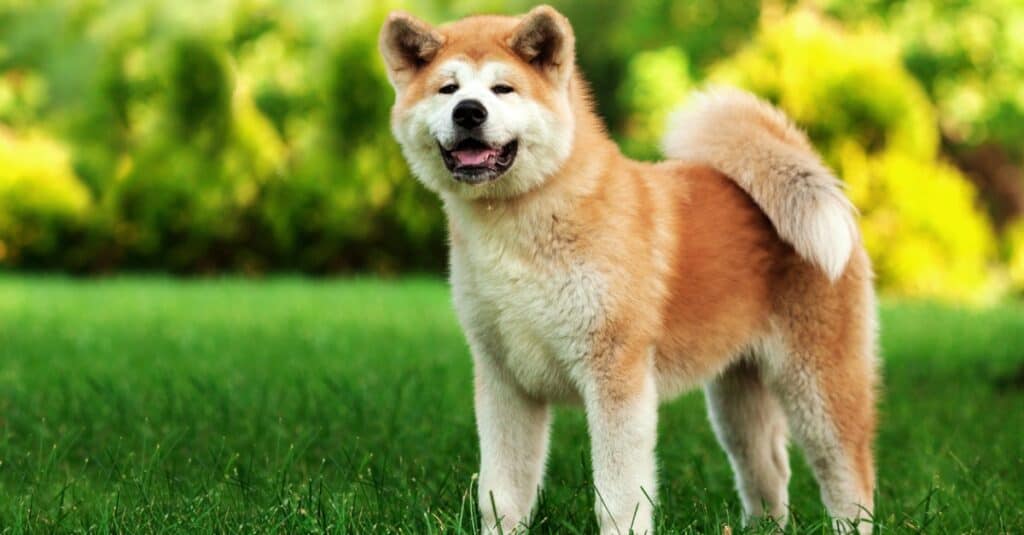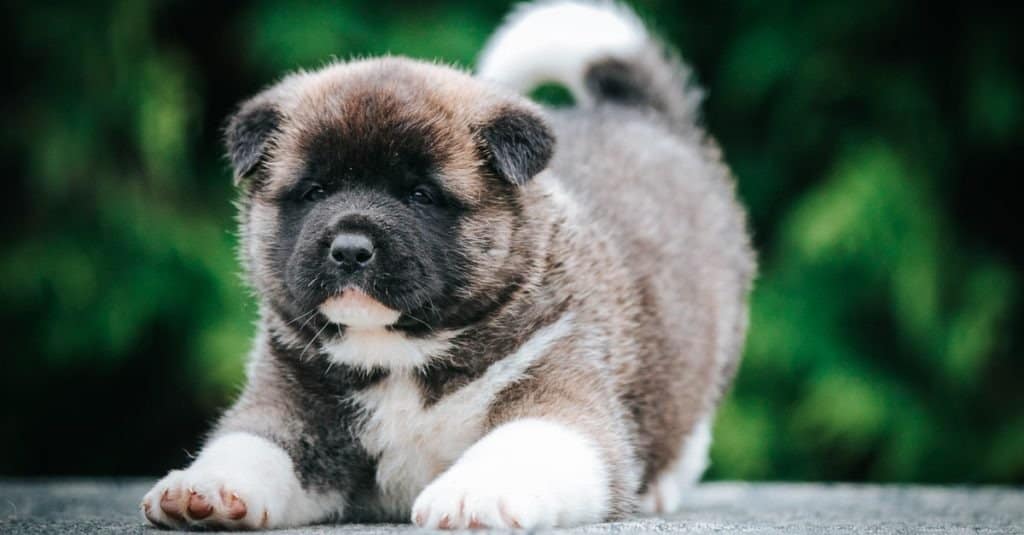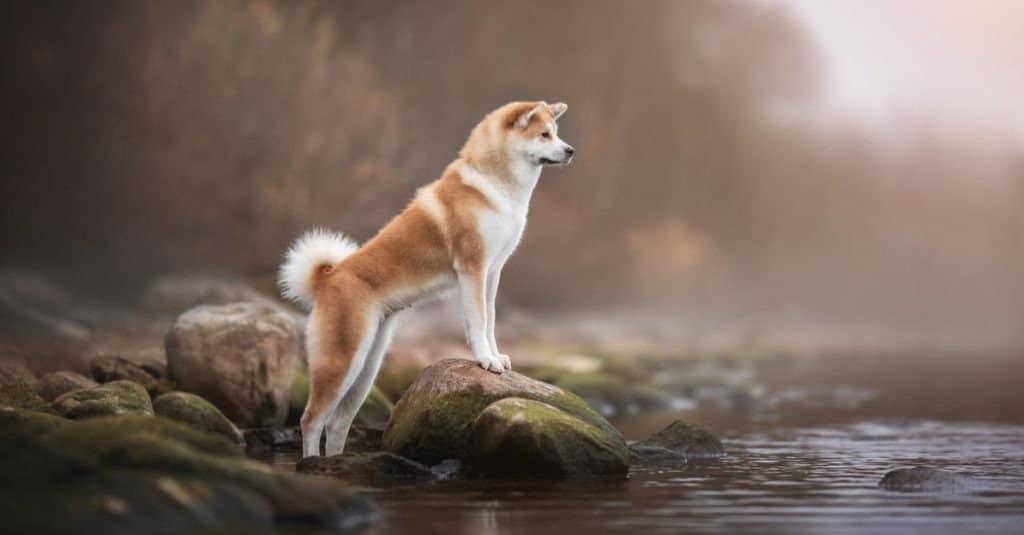In the 1940s, Akitas were brought to the United States, where a new breed, the American akita, was formed. For a long time, there was only Japanese Akita, which are now registered with the American Kennel Club (AKC). But eventually, there were two types of Akita.
Though the AKC groups both breeds as “Akita,” the following article will explore the key differences between the American and Japanese Akitas.
Japanese Akitas are smaller with fox-like faces, while American Akitas are stocky with boxy, bear-like faces. American Akitas have more accepted coat colors under AKC breed standards and tend to be more affectionate toward their families, while Japanese Akitas are also loving but more independent.
Types of Akita: Japanese Akita vs. American Akita

A Japanese Akita.
©TatyanaPanova/Shutterstock.com
Japanese and American Akitas are very similar because they have the same ancestors. However, they’ve been bred differently since the 1940s due to varying breed standards.
The following are the biggest differences between the two:
Size
American Akitas are larger, standing at 24-28 inches tall and weighing 70-130 pounds. In comparison, Japanese Akitas are 22.5-27.5 inches tall and weigh 55-75 pounds.
In both types of Akita, males are larger than females.
Lifespan

American akitas are known for being family protectors.
©Kseniia Kolesnikova/Shutterstock.com
American Akitas live an average of 10-14 years, while Japanese Akitas typically live 10-12 years. This means that American Akitas are more likely to have a longer lifespan.
Coat Color
The American Akita breed standard accepts many coat colors including:
- Black
- Brown brindle
- Fawn
- Red
- White
- Brown with a black overlay
- Red with a black overlay
- Fawn with a black overlay
- Silver with a black overlay
They can also have the following markings:
- White mask with white markings
- Black mask with white markings
- Black and white mask with black markings
- Pinto with a black and white mask
- Pinto with a black mask
The Japanese Akitainu is bred in fewer colors with only brindle, red, and white accepted by breed standard. They can also have white markings.
Face and Body Shape

The Akita is a protective, loyal breed.
©Tatyana Kuznetsova/Shutterstock.com
American Akitas have boxier heads and faces that are often compared to bears. Japanese Akitas have slimmer, fox-like faces.
In addition, American Akitas are much stockier. Although there isn’t too big of a height difference between the breeds, the extra muscle on American Akitas means they weigh considerably more–sometimes more than double the weight of a Japanese Akita!
Temperament
American Akitas tend to be more affectionate toward their families, while Japanese Akitas are more independent than snuggly.
When it comes to strangers, both dogs were bred to guard and therefore are wary. It’s important to socialize them well at a young age and to keep them on-leash and in your control in public.
American Akitas may be slightly friendlier toward strangers but are still likely to have their guard up. They’re also higher energy and will require more exercise than Japanese Akitas.
Japanese Akitas are more aloof and tend to be more prone to barking as well, while American Akitas are quieter. Keep in mind that any dog, when not properly cared for, trained, and exercised, can develop problematic behaviors like excessive barking.
Trainability
Neither types of Akita are people-pleasers, but Japanese Akitas tend to be more aloof and stubborn. You’ll still see some of this in an American Akita, and neither breed is recommended for inexperienced dog guardians.
Always use force-free methods when training dogs. This means using positive reinforcement, like praise and treats, and ignoring, preventing, or redirecting unwanted behaviors.
Avoid positive punishment, which means adding something your dog dislikes in order to punish them. This includes yelling, hitting, shock collars, and other aversives.
These methods are less effective and sometimes abusive. They harm the relationship between you and your dog, and they’re also unnecessary once you learn how to train a dog properly.
Shedding Level

An American Akita puppy.
©Eve Photography/Shutterstock.com
American Akitas shed moderately most of the year, but they do have two big shedding seasons in the spring and fall where they blow out their undercoat. During this time, their fur will shed in clumps.
Japanese Akitas also blow out their coats twice yearly, while also shedding more profusely year-round. They require more grooming as well, which we’ll discuss in more detail below.
Are There Miniature Akitas?
The Miniature Akita is not a breed recognized by the AKC. However, unethical breeders may breed small Akitas by crossbreeding, introducing dwarfism into their breeding line, or continuously breeding the runts of the litter until they achieve their desired size.
These methods are unethical because they increase the puppies’ risk of developing health problems. These kinds of breeders are typically interested in profits above everything else and put the appearance of their puppies before their wellbeing.
If you’d like a miniature Akita, I recommend adopting a Shiba Inu or other small Spitz breed instead. Do your research to find an ethical breeder who performs genetic health testing, or adopt from a rescue or shelter!
Are Akitas Good Guard Dogs?
Both types of Akita make excellent guard dogs. It’s what they’re bred for, after all!
Keep in mind, though, that owning a large guarding breed is a lot of responsibility. They can be prone to aggression, especially if they’re poorly trained or not properly socialized.
Never use aversive training methods with any breed, but especially with Akitas. It’s also not a good idea to try training aggression toward strangers, as this can go very wrong. Remember, they already have an instinct to guard their home and family!
It’s also important to keep your Akita on-leash or enclosed at all times, because they have a high prey drive that can override their recall training. They can also be dog aggressive, which may put other animals at risk if they do get loose.
Do Akitas Make Good Family Dogs?
Akitas can make good family dogs for the right family. This family should be knowledgeable about dogs and teach their children how to interact properly with them. No dog and child should ever be left unattended, no matter the dog’s breed.
Akitas are large, and this makes them more of a risk to children. They can hurt them even by mistake through rough play. Some Akitas aren’t good with children, while others love them. It depends on personality and the dog’s history.
It’s typically best for Akitas to be the only pet in the household. They have high prey drives, and might see small pets, cats, or smaller dogs as prey. It’s impossible to completely override a dog’s prey drive.
Akitas are also prone to dog aggression, which means they might be aggressive even to larger dogs in the household. While this isn’t a guarantee and every dog is different, it’s important to keep this in mind before adopting.
Do Akitas Shed a Lot?

American Akitas need to be brushed weekly while Japanese Akitas should be brushed once every few days.
©Liudmila Bohush/Shutterstock.com
Japanese Akitas shed more than American Akitas and also require more grooming. While American Akitas need to be brushed weekly, Japanese Akitas should be brushed once every few days. Both need more grooming during their shedding seasons twice a year.
Speaking of shedding season, this is when you’ll see them shed the most! My sister’s dog is part Akita, and I can attest that they begin to shed in clumps that you can pull right off. It’s a lot of work for the vacuum and the dog brush!
To keep your home clean and your dog comfortable, it’s best to brush them daily during shedding season. You’ll also want to invest in a good vacuum with attachments to get on top of furniture and into corners. I like having a handheld vacuum for the stairs, or an upright that can convert to handheld when needed so you aren’t carrying a heavy vacuum up and down the stairs.
Up Next:
The photo featured at the top of this post is © Happy monkey/Shutterstock.com
Ready to discover the top 10 cutest dog breeds in the entire world?
How about the fastest dogs, the largest dogs and those that are -- quite frankly -- just the kindest dogs on the planet? Each day, AZ Animals sends out lists just like this to our thousands of email subscribers. And the best part? It's FREE. Join today by entering your email below.
Thank you for reading! Have some feedback for us? Contact the AZ Animals editorial team.






